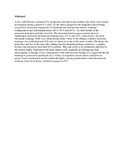| dc.contributor.author | Kähkönen, Marketta | |
| dc.contributor.author | Gripenberg, Ulla | |
| dc.contributor.author | Meme, Julius S | |
| dc.date.accessioned | 2013-06-30T10:21:00Z | |
| dc.date.available | 2013-06-30T10:21:00Z | |
| dc.date.issued | 1980-12 | |
| dc.identifier.citation | MEME, J. S., GRIPENBERG, U. and KÄHKÖNEN, M. (1980), Fanconi's anaemia; chromosome breakage in a large African family. Hereditas, 93: 255–260 | en |
| dc.identifier.uri | http://erepository.uonbi.ac.ke:8080/xmlui/handle/123456789/42842 | |
| dc.description.abstract | A boy with Fanconi's anaemia (FA), his parents and nine living brothers and sisters were serially investigated during a period of 5 years. As the illness progressed the propositus showed high, successively increasing frequencies of chromatid and chromosome breaks, exchange configurations and endoreduplications (36 %, 50 % and 60 %). An older brother of the propositus had died, probably from FA.
The interrelated heterozygous parents showed significantly increased chromosome breakage rates (15 % and 10 %, respectively), the sister chromatid exchange (SCE) was within normal limits. None of the siblings exhibited abnormal breakage, nor could increased SCE rates be observed in any of the series studied.
The father, the propositus and five of the nine other siblings had flat thenar/hypothenar eminences, a slightly deviant trait previously described in FA patients. This trait seems to be dominantly inherited in the present family.
Depletion of the bone marrow cells, gradually developing into fatal pancytopenia, is thought to be a consequence of the chromosome damage. It is suggested that the breakage is caused non-specifically by a variety of exogenous factors and is cumulative in nature. Such a mechanism would explain the highly varying manifestation of the chromosome breakage observed in homo- and heterozygotes for FA | en |
| dc.language.iso | en | en |
| dc.title | Fanconi's anaemia; Chromosome breakage in a large African family | en |
| dc.type | Article | en |
| local.publisher | Department of Paediatrics & Child Health | en |

